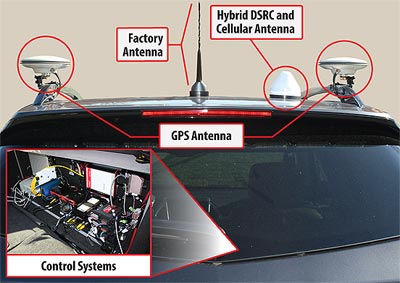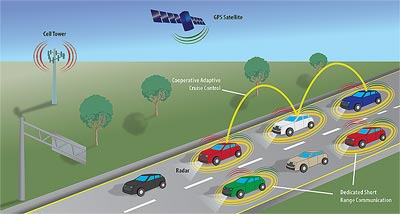U.S. Department of Transportation
Federal Highway Administration
1200 New Jersey Avenue, SE
Washington, DC 20590
202-366-4000
Federal Highway Administration Research and Technology
Coordinating, Developing, and Delivering Highway Transportation Innovations
| FACT SHEET |
| This fact sheet is an archived publication and may contain dated technical, contact, and link information |
| Publication Number: FHWA-HRT-15-032 Date: April 2015 |
Publication Number: FHWA-HRT-15-032 Date: April 2015 |
PDF files can be viewed with the Acrobat® Reader®
The Federal Highway Administration (FHWA) Office of Operations Research and Development, located at Turner-Fairbank Highway Research Center (TFHRC), added five new research vehicles to FHWA’s Innovation Research Vehicle Fleet. This fleet offers an experimental connected automation research platform that provides advanced capabilities for future operational concepts and supports their evaluation. In addition, the fleet’s research platform enables full automatic control of longitudinal movements (such as acceleration and braking) with the flexibility to support lateral control (such as steering controls) for future autonomous vehicle research.
Cooperative Adaptive Cruise Control (CACC) is the first operational implementation developed and tested on the new research platform. CACC allows vehicles to communicate with each other to enable a group of vehicles to implement coordinated advanced applications on freeways and arterials. For example, researchers have leveraged the longitudinal control capabilities provided by the research vehicle platform to deliver speed commands in real-time in order to experiment with speed harmonization. The platform technology also allows the vehicles to use 5.9 GHz Dedicated Short Range Communication (DSRC) and cellular communications to share speed, heading, location, and gap information with each other for advanced applications (such as platooning) in managed lanes.
The CACC implementation will provide the ability to test the open architecture of the vehicle fleet technology platform and assess the ability of researchers to use the vehicle fleet to support the study of operational concepts and connected automation applications.
Innovation Research Vehicle Fleet Benefits:
 |
| Test Vehicle Equipped with Cooperative Adaptive Cruise Control Technologies |
To advance emerging concepts, technologies, and applications, the vehicles are retrofitted to take advantage of the latest in-vehicle safety technologies—including Automatic Collision Prevention, Forward Collision Alert, Lane Departure Warning, Side Blind Zone Alert, and Full-Range Adaptive Cruise Control. The research team developed the CACC strategy by layering a new control system on top of the vehicle’s factory-equipped adaptive cruise control system. This allows an onboard computer to safely intercept the data transmitted from the vehicle’s forward looking sensors and camera and effectively command the vehicle’s speed by accelerating or braking.
The three major components of the research platform are: Communications, Positioning, and Vehicle Control.
Communication
The vehicle fleet is equipped with 4G/LTE, Wireless Fidelity (Wi-Fi), and DSRC connectivity through multiple devices, which maintain maximum flexibility for future communication needs. The platform uses the communication media of choice for communications-based active safety systems that will enable V2V and V2I wireless communications.
Positioning
The vehicles fleet is equipped with a localization system that provides continuous positioning for ground vehicles. This system provides a multisensor fusion of dual-GPS receivers, inertial sensors, and wheel speed sensors to provide real-time position, orientation, velocity, and time information. Real Time Kinematic (RTK) corrections, available from the base station at TFHRC, are also used to enhance the precision of the absolute geodetic vehicle positions. All data are continuously updated even if an immediate GPS fix is not available, allowing for operation during GPS degradation or complete signal loss.
 |
| Cooperative Adaptive Cruise Control Equipment Platform |
Vehicle Control
Vehicle longitudinal control is achieved using a locally created software control module consisting of a set of two independent electronic control units (ECU).
The new vehicles will serve as the next generation research vehicle fleet and will provide the capability to develop and test connected automation concepts over the next 5 years.
 |
| Cooperative Adaptive Cruise Control Platoon Scenario |
For more information, please contact: Taylor.Lochrane@dot.gov